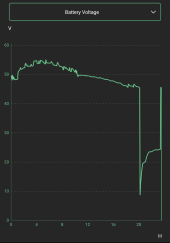I've been playing with a toy solar system using an EG4 3000EHV-48. I have a problem with the battery draining all evening/night when in AC bypass mode. This causes the battery to go into protect mode by the morning, and I need to "jump start" it with a dedicated charger before it can be charged again.
The battery is connected to an (externally powered) shunt. It shows that even when the EG4 inverter reports it is running in bypass mode, it draws about 0.3 amps from the battery until it hits ~45v and the battery goes into protect mode. If I turn off the inverter, the current draw drops to around 0.2 amps but doesn't stop. If I disconnect the battery from the inverter, the current draw goes to zero. I have verified that the current draw is real by removing the shut from the picture and using a multimeter to measure the current and voltage drop while the inverter says it is in bypass mode.
Perhaps related, even though the inverter is set to change only using solar, sometimes it decides to quickly charge the battery when it reaches ~46v up to around 47v (at ~6 amps which corresponds to the 2A max utility current rate setting).
The settings I believe are relevant are as follows:
5 - Battery Type - USE (User Defined)
11. Max Utility Charge Current - 2A
12. Back to Utility - 48v
13. Back to Battery - 50v
16. Charge Source Priority - OSO (Only Solar)
29. Low DC Cutoff - 46v
I've attached a battery voltage curve from a few days ago from the SmartESS app showing what a typical day looks like. Please help me determine if this is expected behavior, if I am doing something wrong, or if I have a defective unit. Thanks!
The battery is connected to an (externally powered) shunt. It shows that even when the EG4 inverter reports it is running in bypass mode, it draws about 0.3 amps from the battery until it hits ~45v and the battery goes into protect mode. If I turn off the inverter, the current draw drops to around 0.2 amps but doesn't stop. If I disconnect the battery from the inverter, the current draw goes to zero. I have verified that the current draw is real by removing the shut from the picture and using a multimeter to measure the current and voltage drop while the inverter says it is in bypass mode.
Perhaps related, even though the inverter is set to change only using solar, sometimes it decides to quickly charge the battery when it reaches ~46v up to around 47v (at ~6 amps which corresponds to the 2A max utility current rate setting).
The settings I believe are relevant are as follows:
5 - Battery Type - USE (User Defined)
11. Max Utility Charge Current - 2A
12. Back to Utility - 48v
13. Back to Battery - 50v
16. Charge Source Priority - OSO (Only Solar)
29. Low DC Cutoff - 46v
I've attached a battery voltage curve from a few days ago from the SmartESS app showing what a typical day looks like. Please help me determine if this is expected behavior, if I am doing something wrong, or if I have a defective unit. Thanks!



